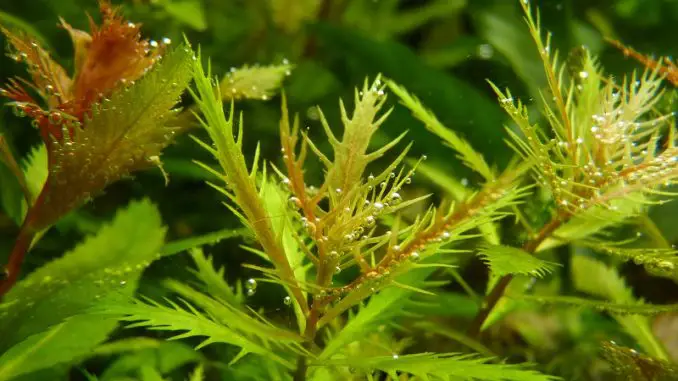
Proserpinaca Palutstris, more easily pronounceable as Mermaid Weed, is one of the more appealing freshwater plants due to its dramatic appearance. The leaves of this unique plant start out green and change to a reddish-pink!
In addition, the shape and texture actually change depending on the lighting in your tank. Growing anywhere from 4 to 16 inches (10 to 40 centimeters) tall and 2 to 6 inches (5 to 15 centimeters) wide, Mermaid Weed will really make your aquarium turn heads. This cool plant is also called Saw-Tooth Hygro, and it is a stem plant that grows in the substrate of your tank, rather than a floating plant.
As amazing as Mermaid Weed might be, if you are a beginning hobbyist, I recommend you wait until you’re a little more experienced before attempting to grow these plants. Known for excessive shedding, it’s important to manage the lighting and water conditions. If you are establishing yourself in the aquarium hobby, it might be better to focus on the fish first and start with easy plants.
Contrary to what you might think from its name, Mermaid Weed is not one of those plants that will grow out of control while you step out for a quick coffee; they’re actually pretty slow-growing plants that require constant pruning.
One of the things that I like about Mermaid Weed is that you can make the plants what you want them to be depending on the lighting and the way you prune them–they can be taller and thinner or wider and denser.
In this article, I’ll cover the background of Proserpinaca Palustris, growing and propagation tips, water parameters, and other considerations for making a thriving biosphere for your plants and aquarium friends.
TABLE OF CONTENTS
Proserpinaca Palustris Facts & Overview
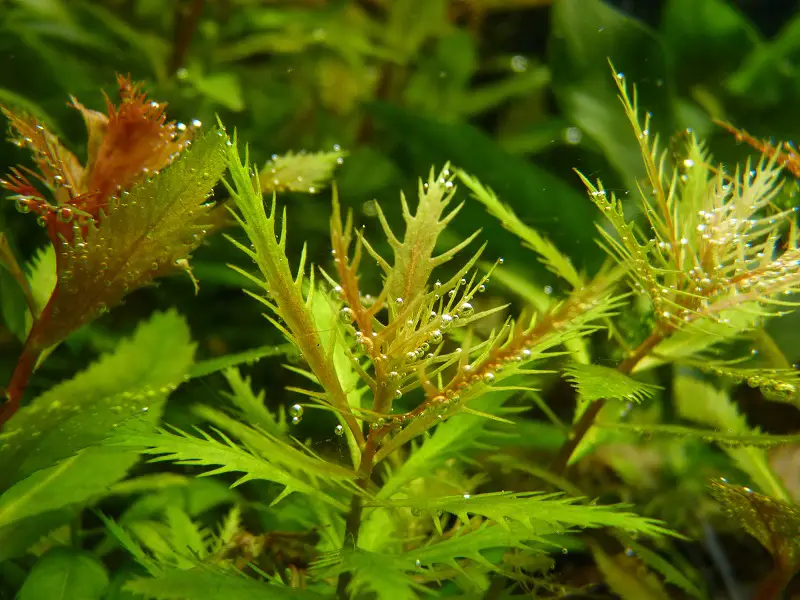
| Category | Rating |
| Care Level: | Moderate to difficult |
| Temperature: | 50°-82° F (10°-28° C) |
| Color Form: | Green, gold, red |
| Propagation: | Cuttings |
| Size: | 4 to 16 inches, pH6.7 |
| Family: | Haloragaceae |
| Minimum Tank Size: | 10 gallons |
| Placement: | Background or midground |
| Lighting: | Bright |
Proserpinaca Palustris is a fern-like aquatic plant that can be found throughout the wetlands of North and South America, as well as the Caribbean. If you are in areas of the northeastern areas of the U.S., you will likely see them in Connecticut, Maine, Massachusetts, New Hampshire, Rhode Island, and Vermont.
Popular in the aquarium trade since the 1950s, some varieties of this herbaceous plant were imported from Cuba for aquariums and ponds.
In the wild, it is usually found partially submerged, but in your home aquarium, it will likely be fully submerged. It can thrive in both conditions.
Mermaid Weed varies in appearance depending on the region in which it grows, and in your home aquarium depending on the size of your tank, the lighting, and how you prune it, so it can look like an entirely different plant in different habitats.
This feature makes it a great choice for those interested in aquascaping, as Proserpinaca Palustris is malleable to your design goals. It is easily adaptable to varying conditions, which is one of the reasons it has spread so successfully through North and South America.
However, because it grows rather slowly, it is not considered to be an invasive species. And although it grows well in a variety of conditions, it does require some particulars in the home aquarium, so I list Proserpinaca Palustris in the moderate care level.
Mermaid Weed is coveted for its intricate leaf pattern and unusual red and gold coloring. Happy in marshes and swamps in the wild, and will do well in the home aquarium with carbon dioxide supplements. In its natural habitat, it does well with humid soil and slow-moving or still waters, and also grows in rivers, lakes, ditches, ponds, pools, and shorelines.
Typical Behavior
One thing that is certain about Mermaid Weed is that it will change. In the wild, Proserpinaca Palustris has leaves that are emersed, or above the water. The roots are underwater but the leaves pop out above the surface. This type of plant is referred to as an emergent plant because it emerges from under the water.
The emersed leaves are serrated and look like the teeth of a saw. Now, in your home aquarium, Proserpinaca Palustris will likely be submersed, which will greatly affect the shape of the leaves, resulting in a long needle-like leaf.
Pro-tip: Of course, depending on how you have designed your aquascape, it is of course possible that you have chosen not to fill the water up to the top of the tank. In this case, your Proserpinaca Palustris will be emergent and you’ll be able to retain some of the saw-tooth look.
Mermaid Weed is a slower-growing plant. You will not likely see Proserpinaca Palustris growing rampant through your tank. Its growth behavior will depend on how often you collect trimmings and replant them.
Appearance
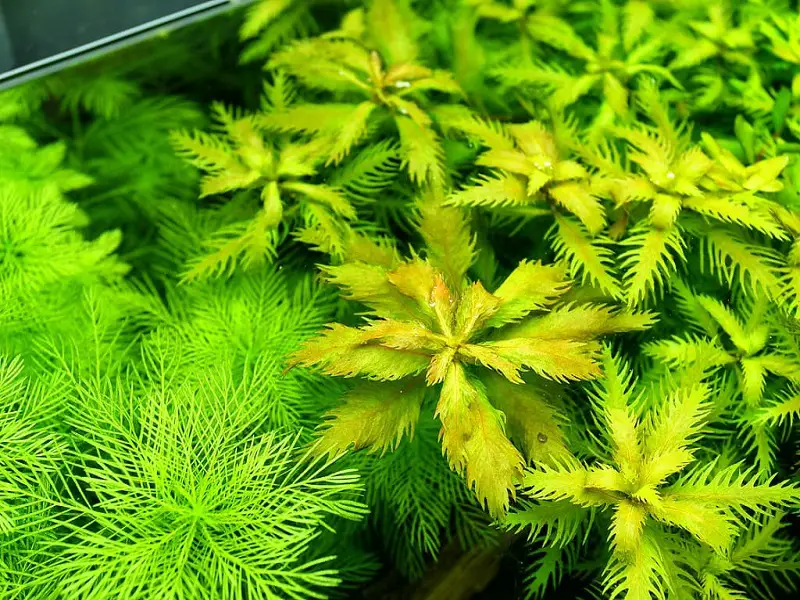
Proserpinaca Palustris is a beautiful-looking plant that quite literally will metamorphize in your aquarium. The submerged and emergent leaves vary in appearance, and the leaf shape and texture vary significantly among the species of Mermaid Weed and by region.
In the wild, Proserpinaca Palustris’ leaves resemble the teeth of a saw, which is how they get one of their names, the Saw-Tooth Hygro. However, in captivity, these lovelies will develop long, needle-shaped leaves. I’ve heard of more than one hobbyist that woke to find a completely changed plant in their aquarium.
The leaves that are above the water look like blades, and those that are submersed look more like feathers. Some even look like tiny hairs. If your plant keeps the saw-tooth effect, the serrated edges of the leaves may frighten off potential predators. You have nothing to worry about though: those serrated edges are pretty soft and won’t stab you.
As your Proserpinaca Palustris grows, the leaves will get rounder and greener (except at the top). The leaves in your home aquarium will likely be 2 to 4 inches (5-10 cm) in length. The plant as a whole will be anywhere from 4 to 16 inches (10 to 40 centimeters) in length and 2 to 6 inches (5 to 15 centimeters) in width.
As for color, Mermaid Weed will likely enter your aquarium in traditional green. However, with nutrients and the proper bright light, the plant’s color will change to a coppery-red at the top. You may even see pink and golden coloration at the tips.
Pro tip: The intense light does not only change the color of the leaves; it also changes the shape and texture. The influence of light will leave the leaves like combs, with a bristle effect.
Each leaf has two (sometimes more!) leaflets. These leaflets have lobes that appear in a line along with the nodes of the stem. On the edges, you’ll also find lobes and sometimes even teeth.
A flowering plant, Proserpinaca Palustris have symmetrical flowers that are .1 to .2 inches (2 to 5 millimeters) in size. They have 3 petals that look like cups when they are attached. You might even see dry fruit develop.
Due to its varied growth regions, Proserpinaca Palustris is now a plant with myriad varieties that have differences that range from subtle to significant. The Cuban Proserpinaca Palustris, for example, has a much different look than what we know as the Marsh Mermaid Weed.
Its unexpected appearance is one of the things I appreciate most about Proserpinaca Palustris.
See related: telanthera cardinalis care
Habitat and Tank Conditions
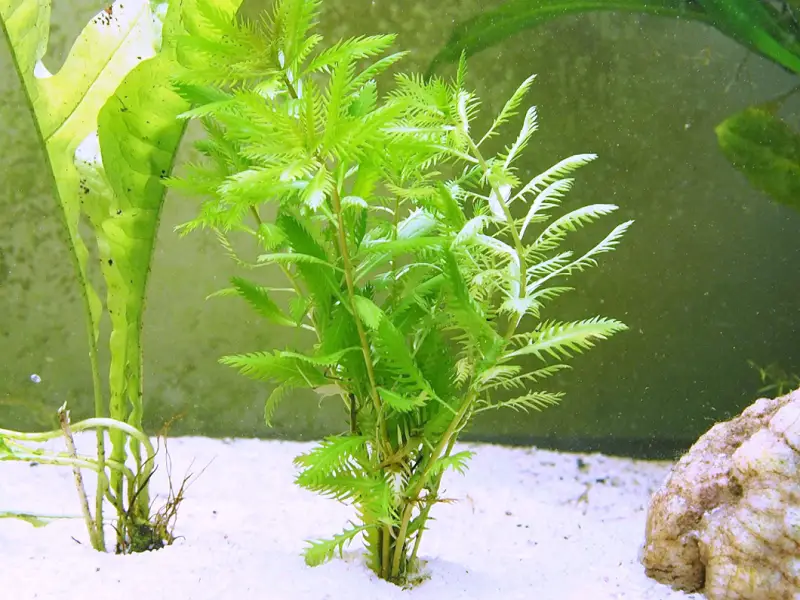
For substrate, I recommend soil, since Proserpinaca Palustris needs the nutrients from the soil, and because they will grow roots. However, if you are adding Mermaid Weed to an established tank that has a different substrate, I don’t recommend switching substrates.
If you dig up your whole substrate, it could be stressful and detrimental to the rest of the tank inhabitants, so it’s better to plant them in what you have.
In the next section, I’ll cover supplements that you’ll need to give your Proserpinaca Palustris.
Water Conditions
For best growth, Proserpinaca Palustris should have sufficient bright light. They will do well with water fertilizers and carbon dioxide supplements. Since you will likely be using a smaller tank, you may not have a filter. If you do have a filter, make sure it does not make the current too strong, as Mermaid Weed is accustomed to still or slow-moving water in their natural habitat.
The optimal parameters to ensure the best quality of life for Proserpinaca Palutstris:
- pH levels: at least 6.7
- Water temperature: 50° – 82° F (10° – 28° C)
What Size Aquarium Do They Need?
I’ve heard of some people growing Proserpinaca Palustris in a 5-gallon micro tank, but I would recommend at least a 10-gallon (40-liter) tank to allow Mermaid Weed to grow up and out.
Planting and Growing
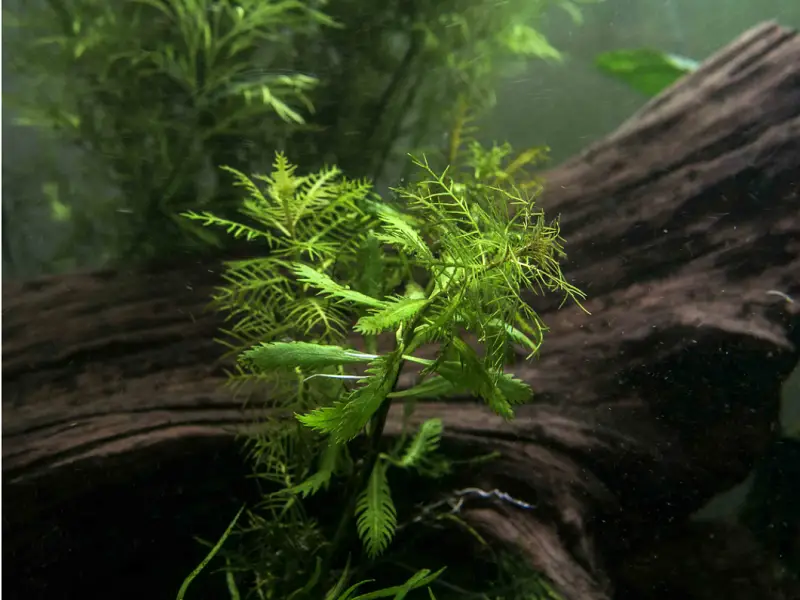
As I mentioned, Proserpinaca Palustris is one of the slower-growing aquarium plants. Your new Mermaid Weed plants will grow in a soil substrate and grow roots after they are planted.
If you keep the light high and offer carbon dioxide supplements, you’ll find that the green leaves go through a metamorphosis and turn to an orangy red.
Propagation can begin when you go to do regular pruning. You’re basically collecting cuttings and then replanting them. Gather cuttings that will laterally shoot off the parent plant. Plant those cuttings into the substrate, and they will also grow roots and become independent plants.
The tops of the stems, which are very colorful, can be clipped and replanted in the substrate. You can either throw out the stem bottoms or leave them in the substrate to give a fuller look. Be sure to remove any decaying clippings, unless of course, you have a cleaner fish.
When you collect the cuttings, the leaves will have serrated edges, but as the Proserpinaca Palustris grows, their leaves will more closely resemble long needles.
See related: lilaeopsis care (Brazilian micro sword)
Care
It is possible to grow Proserpinaca Palustris in smaller aquariums since it grows more slowly than some other aquarium plants. However, you don’t want to go too small since they do still need room to grow. Plus when you grab clippings as you prune, you’ll want to have somewhere to plant those.
One care issue is that in captivity, they have a tendency to shed a lot of leaves if they don’t get the proper nutrients from the water. You should add water fertilizers and treat them with carbon dioxide injections to keep them healthy.
If they shed too many leaves, you’re going to have some dirty water with too much ammonia and nitrate, which is not good for your fish or your Mermaid Weed. Plus you don’t want to ruin the fantastic look that these plants give your aquarium.
Also, I would think twice before adding Proserpinaca Palustris to a tank with goldfish, who will likely consume the plant-like candy. However, if you are looking for a source of nutrition for your fish, Mermaid Weed will fit the bill for tadpoles, who will snack on them and get much-needed nutrition.
Truth be told, though, not many aquatic creatures are super interested in eating Proserpinaca Palustris, so you don’t have to worry about your plants getting destroyed.
Is Proserpinaca Palustris Suitable for your Aquarium?
Proserpinaca Palustris, or Mermaid Weed, can be a great addition to your home aquarium, or even your outdoor pond. These plants are beautiful and unique in both color and leaf features and don’t require as much pruning as some aquarium plants.
Additionally, Mermaid Weed is not difficult to acquire, and because they are not considered an invasive species, you don’t have to worry about disposal, as you do with some aquatic plants like Guppy Grass.
While not recommended for absolute beginners in the hobby, Proserpinaca Palustris is not extraordinarily difficult to care for. I recommend background or midground placement.
What does your Proserpinaca Palutstris look like? I’d love to hear a description of their colors and leaf patterns. Have you designed them to grow sideways or up? Share some details in the comments below!

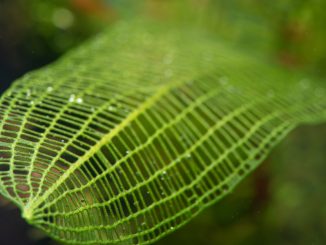
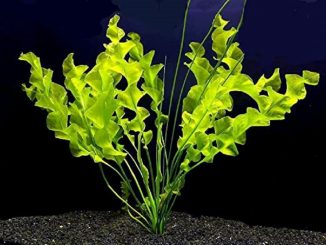
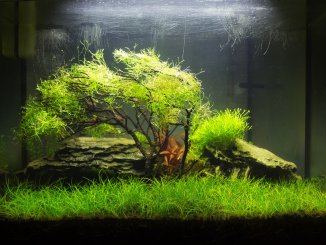
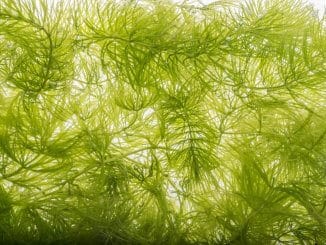
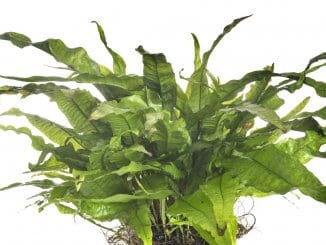
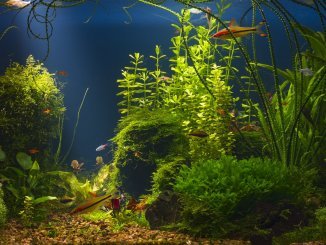
Be the first to comment